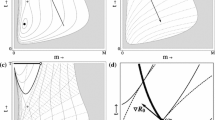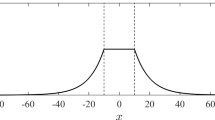Abstract
The goal of this paper is to test theoretical predictions about the effects of seed banks on population dynamics and extinction rates in variable environments using simulations based on data from a natural population of the winter annual Collinsia verna. In the simulations, we varied the frequency of demographically good and bad years and the autocorrelation between conditions in consecutive years to examine the impact of seed dormancy on population growth rate, extinction rate and time to extinction. The existence of a seed bank enhanced population growth rates under all environmental regimes except when good years were very frequent, but this enhancement was minimal. In addition, the presence of the seed bank decreased the likelihood of extinctions and increased the time to extinction. The time to extinction was longest when the environmental conditions were most unpredictable.
Similar content being viewed by others
References
Bierzychedek P (1982) The demography of jack-in-the-pulpit, a forest perennial that changes sex. Ecol Monog 52: 335–351
Caswell H (1986) Matrix models and the analysis of complex plant life cycles. Lectures on Mathematics in Life Sciences 18: 171–234
Caswell H (1989) Matrix Population Models, Sinauer Press, Sunderland, MA
Charlesworth B (1989) Evolution in age-structured populations. Cambridge University Press, Cambridge, England
Cohen D (1966) Optimizing reproduction in a randomly-varying environment. J Theor Biol 12: 119–129
Cohen D (1967) Optimizing reproduction in a randomly varying environment when a correlation may exist between the conditions at the time a choice has to be made and the subsequent outcome. J Theor Biol 16: 1–14
Cohen D, Levin SA (1987) The interaction between dispersal and dormancy strategies in varying and heterogeneous environments. In: Teramato E (ed) Mathematical topics in population biology, morphogenesis and neurosciences. Lecture notes. Biomathematics 71: 110–122
Cohen JE (1979) Comparative statistics and stochastic dynamics of age-structured populations. Theor Pop Biol 16: 159–171
Cooper WS (1984) Expected time to extinction and the concept of fundamental fitness. J Theor Biol 107: 603–629
deKroon H, Plaisier A, vanGroenendael J, Caswell H (1986) Elasticity as a measure of the relative contribution of demographic parameters to population growth rate. Ecology 67: 1427–1431
Efron B (1982) The jacknife, the bootstrap and other resampling plans. Society for Industrial and Applied Mathematics, Philadelphia
Ellner S (1985) ESS germination strategies in randomly varying environments. I. Logistic type Models. Theor Pop Biol 28: 50–79
Gotelli NJ (1991) Demographic models for Leptogorgia virgulata, a shallow-water gorgonian. Ecology 72: 457–467
Harrison S, Quinn JF (1989) Correlated environments and the persistence of metapopulations. Oikos 56: 293–298
Kalisz S (1991) Population dynamic of an age-structured annual. I. Life table analyses of the seed bank and plant cohorts. Ecology 72: 575–585
Kalisz S, McPeek MA (1992) Demography of an age-structured annual: projection matrices, elasticity analyses and seed banks. Ecology 72: 575–585
Klinkhamer PGL, DeJong TJ, Metz JA, Val J (1987) Life history tactics of annual organisms: The joint effects of dispersal and delayed germination. Theor Pop Biol 32: 127–156
Lande R, Orzack SH (1988) Extinction dynamics of age-structured population in a fluctuating environment. Proc Nat Acad Sci (USA) 85: 7418–7421
Leck MA, Parker VT, Simpson RL (1989) Ecology of Soil Seed Banks. Academic Press, San Diego
Levin SA, Cohen D, Hastings A (1984) Dispersal strategies in patchy environments. Theor Pop Biol 26: 165–191
Lewontin RC (1965) Selection for colonizing ability. In: Baker HG, Stebbins GL (eds) The Genetics of Colonizing Species. Academic Press, New York
MacDonald N, Watkinson AR (1981) Models of an annual plant population with a seedbank. J Theor Biol 93: 643–653
McPeek MA, Holt RD (1992) The evolution of dispersal in spatially and temporally varying environments. Am Nat 140: 1010–1027
McPeek MA, Kalisz S (1993) Sampling and bootstrapping in complex designs: demographic analyses. In: Scheiner S, Gurevitch J (eds) Design and Analysis of Ecological Experiments. Chapman and Hall
Mertz DB (1971) Life history phenomenon in increasing and decreasing populations. In: Patil GP, Pielou EC, Waters WE (eds) Statistical Ecology, Pennsylvania State University Press, University Park, PA, USA
Pacala SW (1986) Neighborhood models of plant population dynamics. 4. Single species and multispecies models of annuals with dormant seeds. Am Nat 128: 859–878
Thompson K, Grime JP (1979) Seasonal variation in the seed banks of herbaceous species in ten contrasting habitats. J Ecol 67: 893–921
Tuljapurkar SD (1982) Population dynamics in variable environments. III. Evolutionary dynamics of r-selection. Theor Pop Biol 21: 141–165
Tuljapurkar SD (1989) An uncertain life: Demography in random environments. Theor Pop Biol 35: 227–294
Tuljapurkar SD, Orzack SH (1980) Population dynamics in variable environments: I. Long-run growth rates and extinction. Theor Pop Biol 18: 314–342
Venable DL (1989) Modelling the evolutionary ecology of seed banks. In: Leck MA, Parker VT, Simpson RL (eds) The Ecology of Soil Seed Banks. Academic Press, New York, pp 67–90
Venable DL, Brown JS (1988) The selective interactions of dispersal, dormancy, and seed size as adaptations of reducing risk in variable environments. Am Nat 131: 360–384
Venable DL, Levin DA (1985) Ecology of achene dimorphism in Heterotheca latifolia. II. Demographic variation within populations. J Ecol 73: 743–755
Woolfenden GE, Fitzpatrick JW (1984) The Florida Scrub Jay. Princeton University Press, Princeton, NJ, USA
Author information
Authors and Affiliations
Rights and permissions
About this article
Cite this article
Kalisz, S., McPeek, M.A. Extinction dynamics, population growth and seed banks. Oecologia 95, 314–320 (1993). https://doi.org/10.1007/BF00320982
Received:
Accepted:
Issue Date:
DOI: https://doi.org/10.1007/BF00320982




